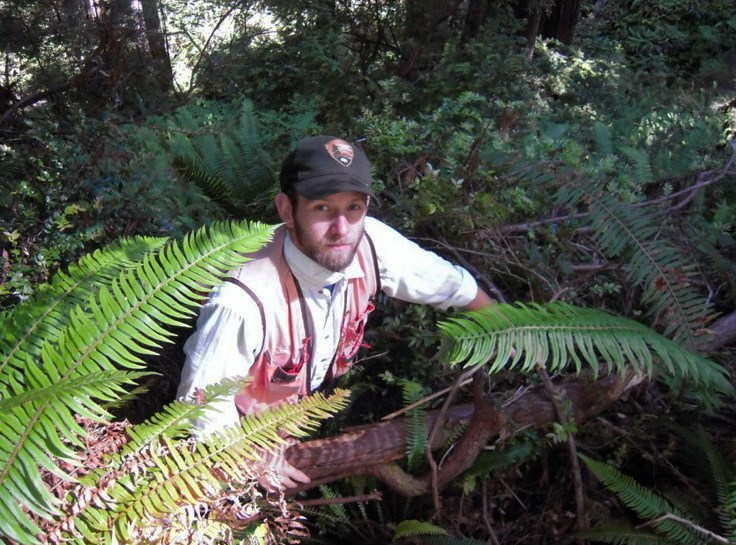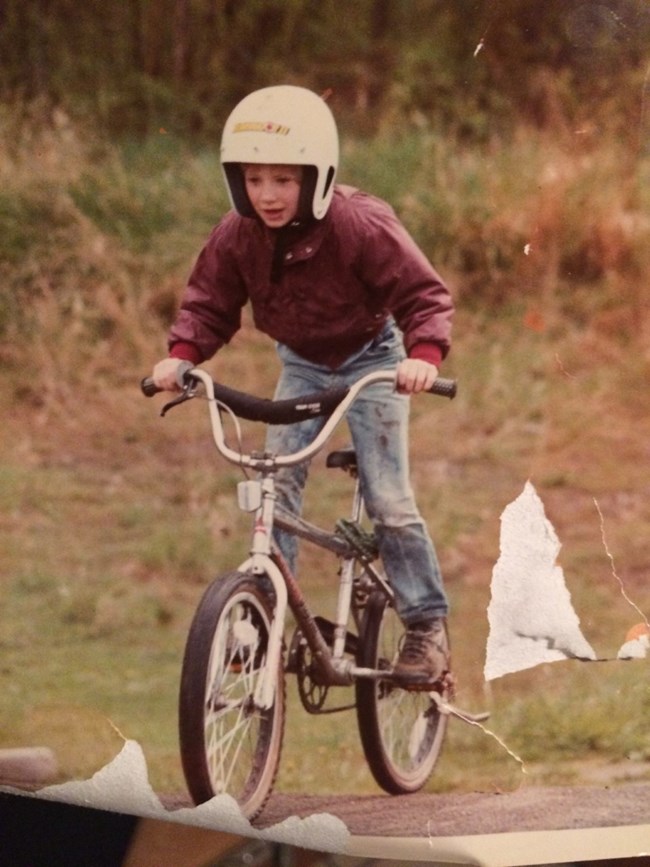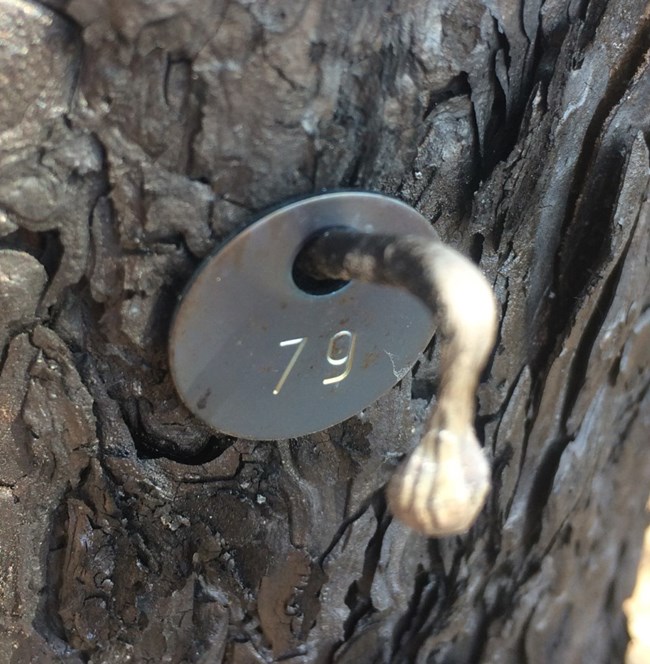Last updated: November 15, 2022
Article
Scientist Profile: Sean Smith, Vegetation Ecologist/Botanist

NPS
Sean Smith’s job offers a hefty dose of variety, which is just how he likes it. As the Vegetation Ecologist for the Klamath Inventory and Monitoring Network, based in southern Oregon, he gets up close and personal with very diverse plant communities in the six parks served by the network. From dense, wet redwood forest tangles in Redwood National Park, to the high desert lava rock landscape of Lava Beds National Monument, to the windy, wide-open mountain slopes of Crater Lake and Lassen Volcanic National Parks, Smith has constant variety in his fieldwork. His office work is equally diverse, from data analysis and report writing, to hiring and training crews, to collaborating with scientists outside the National Park Service. He’s never doing one thing for too long.

Early Years
Smith grew up in Bellingham, Washington, always connected to plants and dirt in some way or another. His grandparents used to take him camping and fishing in the nearby mountains. He recalls digging dirt and moving plants around to help his mother and grandmother in their beloved gardens. He has also loved mountain biking from an early age—buying his first mountain bike at age 14 at the cost of an entire summer’s worth of earnings.
Education and Foundational Work
At Western Washington University, Smith studied biology, with a special interest in mosses and fungi. He attributes this to his first plant biology class being taught by an inspiring mycologist who infused the entire class with a “flavor of fungi” while glossing over (!) vascular plants. Near the end of his college days, he had a memorable experience that cemented his interest in botany. Sick with a fever while studying for a final exam, he dreamed he was trapped inside a plant cell, watching all the organelles at work, almost as if he could reach out and touch them. Not surprisingly, he aced the final exam and came to the conclusion that plants were in his brain to stay.
Smith went on to work seasonally as a field botanist and eventually completed his MS from Southern Oregon University. He created a dichotomous key to the plants of Lava Beds National Monument for his master’s thesis, which became its official, published flora. Writing A Flora of Lava Beds National Monument opened the door to his first permanent job with NPS as the Klamath Network’s botanist. Throughout those early years, he felt fortunate to find himself in the right place at the right time, again and again.
Current Job
Smith keeps busy leading three different vital sign monitoring protocols: vegetation communities, whitebark pine, and early detection of invasive plant species. Summer fieldwork involves training field crews for the vegetation and invasive species programs, and then collecting data himself with one intern for the whitebark pine monitoring protocol.
“Doing the whitebark pine is the best. You’re at Crater Lake or Lassen in August, at high elevation. Hopefully it’s not smoky. You’ve got nice air quality, good views, good temperature—typically not very hot. Not a lot of bushwacking. No insects, no ticks, no poison oak. Usually mosquitoes are not that big of a deal.”
In contrast, some of the hardest fieldwork takes place in a much lower elevation park, Whiskeytown National Recreation Area. While blessed with a large lake and enticing streams and waterfalls, Whiskeytown can be a challenging place for outdoor work. Summer temperatures regularly reach 105° and higher, while ticks, poison oak and dense bushwhacking try the patience of even the most hardy field techs. He describes his crew’s experience two summers ago:
“It’s just insanely hot and there’s bushwhacking through poison oak all the time. People were starting to get right on the edge of their physical and emotional wellbeing. Not sleeping well, having poison oak. Being really itchy.”
Field crews haul with them an assortment of instruments to collect data in the field. (Given the range of conditions field crews might face, one obvious tool of the trade is Tecnu – poison oak relief cream!) Field gear includes a hand lens for magnifying miniscule plant parts, plot layout tapes, a clinometer for measuring tree height, a densiometer to measure canopy closure, the Jepson manual for plant identification, a field tablet for data entry, an emergency radio, and a plant press to collect unusual specimens.
Regardless of heavy equipment loads and challenging conditions, Smith reflects on a certain experience of outdoor work that he often shares with his field crews. Waiting for that moment in each day when something especially thrilling happens, like when the light’s just right, almost surreal, shining through a spider web. That moment you remember you are working in a beautiful natural area and it makes all the hard work worthwhile.
Back in the office, during the fall and winter, Smith’s “office jockey” duties range from managing and analyzing data, writing reports, repairing and ordering equipment, and preparing to hire for the upcoming field season to various external collaborations. He has taught botany classes for the southern Oregon based Siskiyou Field Institute. He collaborates with other networks and outside researchers to make the most of monitoring data. For example, the whitebark pine protocol is shared among several I&M networks that also selected this keystone species as a vital sign. Working with multiple networks requires more coordination but also offers opportunities to coauthor peer-reviewed journal articles stemming from the large and multifaceted effort to conserve this important species. Additionally, Smith collaborates on complex statistical analyses. Managing three protocols leaves him little time to do the valuable in-depth data analyses of his growing long-term datasets. He partners with statistical wizards at USGS and nearby Humboldt State University to do some of the more complex analyses of vegetation and whitebark pine data, offering them high quality data sets and funding in exchange for their analytical support. An added benefit to both the analyst and NPS is that these projects often result in a peer-reviewed scientific publication, extending the reach of new findings beyond the NPS natural resource report series.

NPS
Reflections
Reflecting on what he loves most about his current job, it’s the contrast in landscapes, and therefore the distinct plant communities that Smith finds so interesting.
“My real passion and focus is plot level species diversity and species richness within parks, as well as turnover from one park to the next. Just looking at the really interesting assortment of plants and how they form different plant communities at different aspects, elevations, climate zones. What is interesting to me is all the change, particularly this area [southern Oregon and northern California] - the vast changes in vegetation community type.”
He’s particularly excited to see how long-term plant monitoring in the parks can help explain disturbance dynamics. Indeed, one of the most valuable results of long-term monitoring is knowing what conditions were like before and after large disturbances, like the large fires that have swept through Whiskeytown NRA, Lassen Volcanic NP, and just this year (2020), Lava Beds NM. The fires have wreaked havoc on some plots, even melting the aluminum nails used to fasten the steel tree tags (and thus sometimes scattering the tags far from their host trees!). Nonetheless, they present a unique opportunity to understand large disturbances using pre- and post-disturbance monitoring data:
“Are we seeing these plant communities return as they were represented in our baseline data or are we seeing a shift? A shift in species composition? A shift in overall habitat type, as the dominant species change? Are we moving through or even skipping over whole functional groups, such as going from a forest to chaparral to grassland? And what’s the trajectory of these community types in the future?”

Fun
Smith is still an avid mountain biker, taking to the forest trails above town as a break from work.
“Biking is one of the few things I can do where I actually can’t look at plants. If you’re staring at a plant for too long, you’re probably going to crash!”
Though his two daughters are still a little too young to join him in the field, the family spends plenty of time together with plants, dirt, and rocks, just like he did as a child. His 2-and-a-half-year-old, Wren, is already showing signs of interest in plants, however. Smith reports that she recently found a book on weeds in the house and has been carrying it around for the past few days, showing him pictures of plants.
“She basically has her own botany book now.”
Article by Sonya Daw, Klamath Inventory and Monitoring Network
Adapted from The Klamath Kaleidoscope newsletter, Fall-Winter 2020 issue
